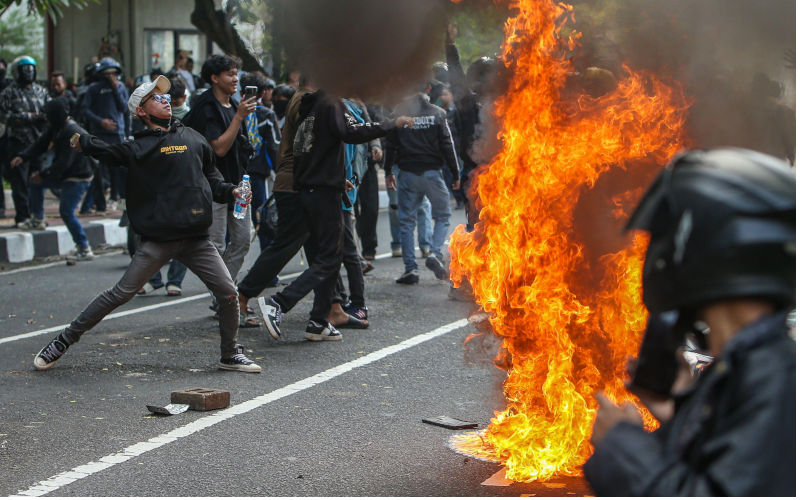The economics of Indonesia’s discontent
September 30, 2025
Economic discontent erupted in protests across Indonesia in late August 2025. The trigger was the proposal to give generous housing allowances to members of parliament, but unrest had been bubbling since early in the year.
Indonesia’s economy has not been growing strongly enough to absorb either the five million people who lost jobs during the COVID-19 pandemic or the expanding working age population into formal employment.
Indonesia’s 5% growth per year and unemployment rate just under 5% appear solid enough – but the statistics hide the underlying problems.
According to the official statistics, four in every five jobs created since 2019 in Indonesia have been in the informal sector, and there were 31.5 million people at the end of 2024 trapped in near poverty with no job security.
President Prabowo Subianto’s Government sought to calm the anger that drove August’s protests by addressing the proximate causes of the demonstrations, withdrawing the housing perks for parliamentarians and promising a full investigation into the heavy-handed police response.
But the underlying causes of the unrest are yet to be acknowledged. The post-pandemic scarring in the labour market is visible – there are not enough jobs for young people, including university graduates. Inflation may be low overall, but many face a cost-of-living crisis with high food prices and education costs. And the quality of governance is slipping backwards.
Less than a year into his term, Prabowo confronts a major test. He has inherited an economy and society yet to fully recover from the COVID-19 pandemic and now facing one of the most hostile and uncertain external environments in living memory.
Only months into his presidency, he had to deal with US President Donald Trump’s 32% tariff on all Indonesian exports into the US. Indonesian manufacturing was already under pressure from a flood of Chinese goods unable to enter the US market from the trade war with China.
Prabowo’s international economic diplomacy has restored some certainty through a co-ordinated ASEAN response that includes a declaration of non-retaliation to the Liberation Day tariffs. Indonesia was also able to negotiate a reduction of US tariffs to 19%. But domestically, policies have done more to exacerbate than relieve the hardship felt by many. Spending increases for the police, military and on priority programs like the Free Nutritious Meals program came at the expense of transfers to provincial and local governments.
After the street riots, Prabowo appears to be listening. An updated 2026 budget reverses plans to further cut government spending, including reducing the scale of cuts to regional government transfers. New Finance Minister Purbaya Yudhi Sadewa announced a stimulus package of almost US$1 billion in mid-September and that will help create some jobs and bring some relief, but that is not a substitute for reform.
The challenge for the Indonesian Government is to improve the quality of economic growth so that it creates secure jobs, reduces poverty and supports the growth of the middle class as it did before the pandemic. And then it is to lift growth potential closer to Prabowo’s ambition of 8% a year. This growth rate may seem unachievable, but given Indonesia’s level of development and the experience of China, India, Vietnam and Indonesia itself for a decade from 1986, it’s not impossible.
Above all, Indonesia needs a substantial dose of reform. In response to the Liberation Day shock, Prabowo announced a bold deregulation agenda in April. But the reforms have not been implemented and the cost of production in Indonesia remains high compared to its peers and neighbours. Indonesia remains largely outside of regional value chains looking in.
Prabowo’s deregulation agenda would open Indonesia up to fuller participation in those value chains by opening up to trade and investment. It includes the removal of import licensing, quotas, investment licensing, local content requirements and non-tariff measures that are barriers to trade and add costs to business.
Indonesia’s international economic diplomacy must lock in the domestic reform agenda. Negotiations with the US resulted in the removal of many non-tariff measures that could be extended to businesses from other countries as ASEAN agreements require. Indonesia led the creation of the Regional Comprehensive Economic Partnership but has yet to reap benefits from its implementation. A comprehensive economic partnership with the European Union was finalised on 23 September 2025, opening new markets. These are relatively easy steps that will boost growth and growth potential.
Bigger changes will come from what’s necessary to join the Comprehensive and Progressive Agreement for Trans-Pacific Partnership and the OECD; Indonesia is at the early stages of trying to join both. Membership requires the removal of import licensing, quotas and local content requirements, consistent with Prabowo’s deregulation plan. It also has implications for costly industrial policies in Indonesia. The changes will help make Indonesian manufacturing competitive by removing a range of measures that add significant costs to manufacturing. OECD membership will also require institutional and governance reform.
Indonesia has natural resources, a young and growing population and is located in the world’s most dynamic region. Global capital is looking for new labour-intensive production bases outside what has become a higher-cost China. Aligning the domestic reform agenda with implementation of RCEP and the ambition to join the OECD club and high-standard CPTPP agreement would help lock in reforms that create secure jobs in the industries of the future.
Republished from East Asia Forum, 28 September 2025
The views expressed in this article may or may not reflect those of Pearls and Irritations.
